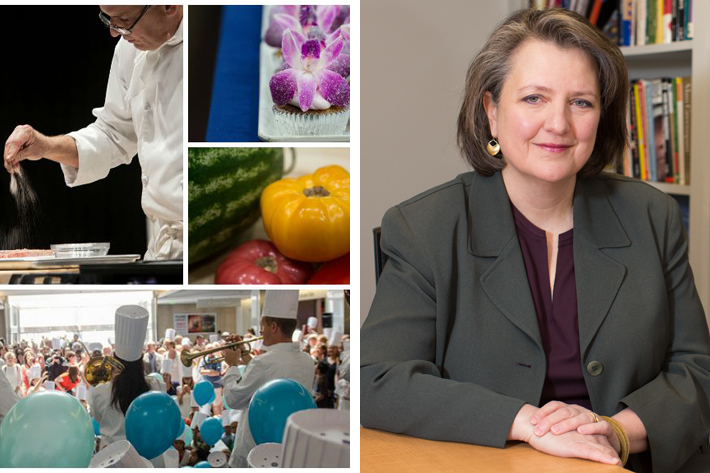In the 21st century, Grant Wood’s “American Gothic” painting of a farmer and his wife standing with rake in hand on a small plot of land has been replaced by urban farms tucked between skyscrapers, sprawling corporate farms sustained by machinery and genetically modified organisms (GMOs).
The tension between the old system and the new raises a question. What does innovation cost American farming?
The Smithsonian National Museum of American History gathered experts across the food spectrum Friday to tackle this issue and others at the Food History Roundtable. The event was the start of the museum’s Food History Weekend and a precursor to the Oct. 24 national observance of Food Day.
George Washington University Executive Director of Sustainability Kathleen Merrigan joined food and agribusiness experts for the “Growing Innovations” panel discussion to examine how issues of the modern food system are shaping the future.
Panelists included Dr. Merrigan, Nikko and David Masumoto, who represented the Masumoto Family Farm in Fresno, Calif., Malik Yakini, the founder and executive director of Detroit Black Community Food Security Network, and Zach Hunnicutt, farmer and partner of Hunnicutt Farms and DWH, Inc.
National Museum of American History curator Peter Liebhold moderated the panel.
Check out three highlights from the roundtable discussion curated by George Washington Today reporter Brittney Dunkins.
1. The organic food industry is only getting stronger.
Dr. Merrigan said that although the process of growing organic crops requires “eyes on acres,” intensive management and a commitment to using crop rotation to improve soil health, farmers are stepping up to the challenge to meet government standards. Mr. Masumoto thanked Dr. Merrigan for her contributions to developing the guidelines when she served as deputy secretary of the U.S. Department of Agriculture.
Dr. Merrigan encouraged consumers to avoid the sensationalized fight over organic crops as seen in the pages of The New York Times, which questions whether organic foods are worth the extra cost to consumers and whether the crops are targeted for wealthier consumers.
“The organic food industry is growing and is stronger than ever,” Dr. Merrigan said. “The organic premium is worth paying.”
2. GMO controversy needs to morph from debate to discussion.
The panelists assumed staunch pro and con positions on the subject of GMOs. While Mr. Yakini took issue with the fundamental concept that GMOs allow a person to patent and own a life form, Mr. Hunnicutt said that the GMO crops on his farm allowed the farmers to stop using harsh chemicals to control weeds because the crops were weed resistant.
“If we demonize GMOs, we are going to give up a lot of future benefits,” Mr. Hunnicutt said. “It’s likely that the next generation of GMOs will be able to adapt to tougher growing conditions.”
Mr. Hunnicutt added that since people are becoming interested in the food system after decades of disinterest, it is farmers’ responsibility to communicate the value of GMOs better.
Both Dr. Merrigan and Mr. Matsumoto agreed that the issue was too complex for a simple pro/con debate. Mr. Matsumoto said that the tension lies in adopting quickly changing technology when farming is “by its nature” very slow.
“It is not about who is for or against. We need to open the floor to scientific discussions,” Dr. Merrigan said.
3. Technology is not just about convenience. It also affects the structure of the industry.
When Dr. Leibhold asked about the tension of scaling up agribusiness with technology, panelists took positons on both sides of the issue. While they agreed that modern agriculture was vested in agricultural advances, they noted that for every improvement the system has shifted, often pushing out workers.
“I am excited about what tech could do for us,” Dr. Merrigan said.
She optimistically pointed out that a milking robot could improve the economic viability of a dairy farmer’s operation. She added that the engineers and farmers working together at Stone Barns Center of Food and Agriculture are taking a holistic view of how technology can improve the lives of farmers.
However, Ms. Matsumoto advocated for “appropriate level technology” because she is concerned that new technology pushes workers down the chain.
“Farmers already have trouble paying workers what they are worth,” Ms. Matsumoto said. “Do we want less people involved in our food system?”
Mr. Yakini said that since technology can perpetuate inequality, it is important to focus on building an equitable system.
“The greatest innovations will be an innovation of our values so that they can guide how we create and use technology,” Mr. Yakini said.


